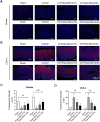Paeoniflorin Alleviates Abnormalities in Rats with Functional Dyspepsia by Stimulating the Release of Acetylcholine
- PMID: 33376306
- PMCID: PMC7764555
- DOI: 10.2147/DDDT.S260703
Paeoniflorin Alleviates Abnormalities in Rats with Functional Dyspepsia by Stimulating the Release of Acetylcholine
Abstract
Introduction: Paeoniflorin is a main active component in traditional Chinese medicine. Paeoniae alba radix is widely used as a spasmolytic and pain-relieving agent for abdominal spasmodic pain. Functional dyspepsia (FD) is characterized by pain or burning in the epigastrium, fullness, bloating and nausea. However, limited information is available about the effect of paeoniflorin on FD.
Materials and methods: In this study, iodoacetamide or clonidine-induced FD rat models were established to investigate the impacts of paeoniflorin on FD induced by different pathophysiologic disturbances.
Results: We found the therapeutic effect of paeoniflorin through assessing the gastric emptying, gastric accommodation and visceral hypersensitivity. This function of paeoniflorin was related to the release of acetylcholine (ACh), which was accompanied by reduced acetylcholinesterase (AchE) activity in stomach and hypothalamus. Paeoniflorin administration inhibited the cyclo-oxygenase-2 (COX-2) expression and increased the level of ghrelin in the stomach. Besides, the levels of occludin and ZO-1 were elevated in the duodenum from paeoniflorin-treated rats, suggesting the impaired duodenal barrier was ameliorated.
Discussion: These results indicate that paeoniflorin possesses the ability to alleviate functional dyspepsia.
Keywords: acetylcholine; functional dyspepsia; gastric function; paeoniflorin.
© 2020 Zou et al.
Conflict of interest statement
The authors report no conflicts of interest in this work.
Figures




Similar articles
-
Modified Liu-Jun-Zi decoction alleviates visceral hypersensitivity in functional dyspepsia by regulating EC cell-5HT3r signaling in duodenum.J Ethnopharmacol. 2020 Mar 25;250:112468. doi: 10.1016/j.jep.2019.112468. Epub 2019 Dec 10. J Ethnopharmacol. 2020. PMID: 31836517
-
Sini-san improves duodenal tight junction integrity in a rat model of functional dyspepsia.BMC Complement Altern Med. 2017 Aug 30;17(1):432. doi: 10.1186/s12906-017-1938-2. BMC Complement Altern Med. 2017. PMID: 28854971 Free PMC article.
-
[Study on blood enriching effects of γ-ray radiation of paeoniflorin and albiflorin on mouse model of blood deficiency].Zhongguo Zhong Yao Za Zhi. 2014 Aug;39(15):2952-5. Zhongguo Zhong Yao Za Zhi. 2014. PMID: 25423839 Chinese.
-
Acotiamide (Z-338, YM443), a new drug for the treatment of functional dyspepsia.Expert Opin Investig Drugs. 2011 May;20(5):701-12. doi: 10.1517/13543784.2011.562890. Epub 2011 Mar 22. Expert Opin Investig Drugs. 2011. PMID: 21417958 Review.
-
Acotiamide, a novel gastroprokinetic for the treatment of patients with functional dyspepsia: postprandial distress syndrome.Expert Rev Gastroenterol Hepatol. 2012 Sep;6(5):533-44. doi: 10.1586/egh.12.34. Expert Rev Gastroenterol Hepatol. 2012. PMID: 23061703 Review.
Cited by
-
Network pharmacology and experimental studies for deciphering the molecular targets and mechanisms of Chaihu Shugan powder in the treatment of functional dyspepsia.Technol Health Care. 2023;31(S1):449-462. doi: 10.3233/THC-236039. Technol Health Care. 2023. PMID: 37038797 Free PMC article.
-
Zhizhu Kuanzhong, a traditional Chinese medicine, alleviates gastric hypersensitivity and motor dysfunction on a rat model of functional dyspepsia.Front Pharmacol. 2022 Nov 17;13:1026660. doi: 10.3389/fphar.2022.1026660. eCollection 2022. Front Pharmacol. 2022. PMID: 36467071 Free PMC article.
-
Traditional Chinese medicine for functional gastrointestinal disorders and inflammatory bowel disease: narrative review of the evidence and potential mechanisms involving the brain-gut axis.Front Pharmacol. 2024 Sep 17;15:1444922. doi: 10.3389/fphar.2024.1444922. eCollection 2024. Front Pharmacol. 2024. PMID: 39355776 Free PMC article. Review.
-
Maslinic acid improves mitochondrial function and inhibits oxidative stress and autophagy in human gastric smooth muscle cells.Open Life Sci. 2025 Jan 27;20(1):20221036. doi: 10.1515/biol-2022-1036. eCollection 2025. Open Life Sci. 2025. PMID: 39881825 Free PMC article.
-
Quercetin Improves Mitochondrial Function and Inflammation in H2O2-Induced Oxidative Stress Damage in the Gastric Mucosal Epithelial Cell by Regulating the PI3K/AKT Signaling Pathway.Evid Based Complement Alternat Med. 2021 Nov 27;2021:1386078. doi: 10.1155/2021/1386078. eCollection 2021. Evid Based Complement Alternat Med. 2021. PMID: 34873406 Free PMC article.
References
-
- Enck P, Azpiroz F, Boeckxstaens G, et al. Functional dyspepsia. Nat Rev Dis Primers. 2017;3:17081. - PubMed
MeSH terms
Substances
LinkOut - more resources
Full Text Sources
Medical
Research Materials
Miscellaneous

